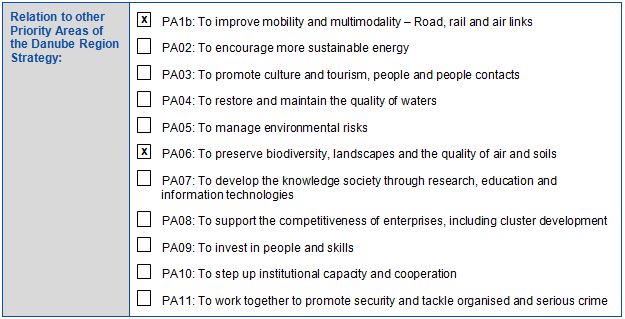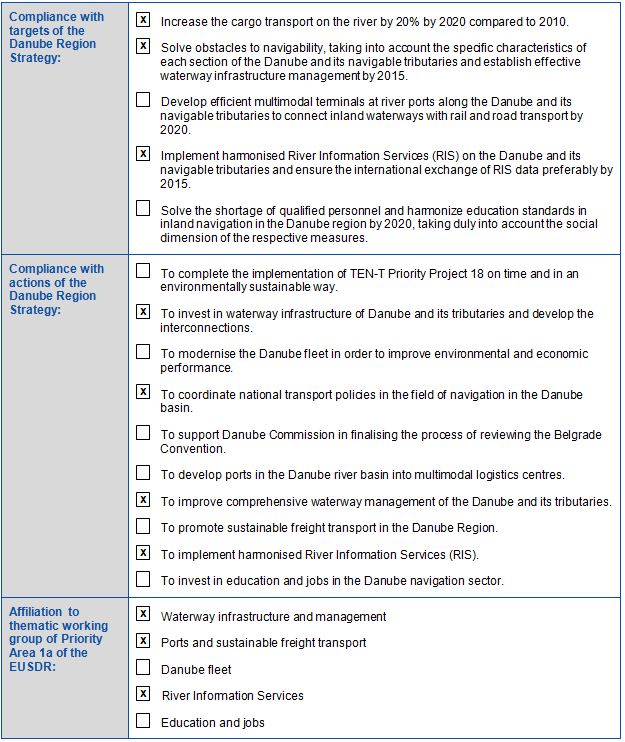BASIC PROJECT DATA
Project ID: PA1A039
Websites: www.savacommission.org; www.vodniputovi.hr
NEED AND ADDED VALUE FOR THE DANUBE REGION STRATEGY
The Sava river is navigable on 594 km of its river course and links the economies of the four Sava riparian states (Serbia, Bosnia and Herzegovina, Croatia, Slovenia), whilst there is in perspective, the implementation of transport infrastructure that would link the Sava with several ports on the Adriatic sea. The existence of port infrastructure on the Sava itself and the connection of the Sava with the Danube provide great advantages for intensifying further development of river transport.
Despite such natural advantages the Sava river waterway has been neglected during the last 20 years and due to the war in 1990 waterway transport was actually the most endangered type of traffic because of damages of the infrastructure such as bridges, which completely stopped traffic at certain locations and river stretches. Navigation was also unsafe due to the presence of unexploded devices and in severance during the reconstruction of the damaged bridges. During the said period, the maintenance of the Sava river waterway was on a low level and this has resulted in a decrease of the widths and depths of the waterway and shorter navigation periods during the year. In addition, due to the decrease of the industrial production and economic problems, freight transport on the Sava, similar to other types of transport, is on a low level and suffers serious lack of financial sources and maintenance.
Although transport volumes in the past were higher than at present (prior to 1990 approx. six million tons annually), the full potentials of waterway transport were not adequately used in the past. This can be illustrated by the fact that waterway transport in EU countries has risen by 12% during the period of 1970–1998 (source: EUROSTAT, European Conference of Ministers of Transport), while waterway transport in countries of Central and Eastern Europe has declined by 20% during the period of 1990–1998 (source: European Conference of Ministers of Transport).
Nowadays, in view of the increased needs for transport in the Sava region, it is obvious that the rehabilitation of waterway transport on the Sava river is extremely important, as it is an environmentally-friendly and sustainable type of transport with extraordinary potential. This is specifically enhanced after the signing and ratification of the Framework Agreement on the Sava River Basin in 2002 and the adoption of the Protocol on the Navigation Regime, according to which navigation on the Sava is free for vessels of all flags.
This project will result in the improvement of the physical capacity of the Sava waterway and it will contribute to the improvement of mobility and multimodality in the Danube region. At the same time, it will contribute to the increase of river transport, to the removal of obstacles to navigability and to the establishment of effective waterway infrastructure management in the Danube and Sava region.
The Sava River is classified as an international waterway class IV from the border of the Republic of Serbia (rkm 211) to Sisak (rkm 594). Currently, the Sava river waterway does not meet the required navigation parameters of international waterway class IV and does not allow for smooth navigation on 300 days/year for vessels with a maximum draft of 2.5 metres.
OBJECTIVE(S) OF THE PROJECT
The main objective of the project is the rehabilitation and development of the Sava river waterway infrastructure and provision of an appropriate economic and organizational framework for restoring trade and navigation (cargo and passenger) on the Sava, with an aim to:
- develop additional required studies and designs
- improve the waterway infrastructure up to class IV and Va by river training measures and other works
- improve public and private investments into transport on the Sava river, in accordance with adequate economic and financial analysis
- apply an integrated approach considering water management, energy production, flood control and environmental aspects in the basin
- integration and modernization of the Bosnia and Herzegovina, Croatian and Serbian infrastructure within the Trans-European Transport Network
PLANNED AND CONDUCTED PROJECT ACTIVITIES
- Feasibility Study completed
- Development of detailed design and EIA for the sector Belgrade (rkm 0) – Brčko (rkm 234): tender procedure for the development of the detailed design finished; contract for the preparation of the detailed design ready for signature (signature expected until the end of 2017); preparation of EIA study underway
- Development of detailed design for the sector Brčko (rkm 234) – Sisak (rkm 594): preparation of the detailed design under way
- Waterway demining in Bosnia & Herzegovina: Tender procedure under way; evaluation of the bids
- Execution of river training works (groynes, sills, bank protection, dredging and bridge reconstruction) foreseen
TRANSBOUNDARY IMPACT
- Republic of Croatia, Bosnia and Herzegovina, Republic of Serbia – river training works will be executed on the territory of these states
- Republic of Slovenia – improved possibilities for multimodal transport
PROJECT BENEFICIARIES / TARGET GROUPS
- Industries in the Sava region (especially steel, oil, fertilizer and agriculture production)
- Shipping industries
- Ports
- Tourism (especially nautical tourism)
- Inland waterway authorities in the Sava riparian countries
STATUS AND TIMEFRAME
Start date: 01/2008
End date: t.b.d.
FINANCING
Total budget: 85,000,000 EUR (estimation from feasibility study)
Planned budget consisting of EU co-financing (Structural Funds and Instrument for Pre-Accession Assistance), national contributions from the state budget (national part in financing from structural funds) and loans from the World Bank or the European Bank for Reconstruction and Development.
Financing is only partly available.
PROJECT TEAM
Project leader: International Sava River Basin Commission (ISRBC)
(website: www.savacommission.org)
For each part of the project (e.g. detailed design, EIA, works) different project leaders will be nominated.
Address: Kneza Branimira 29, Zagreb / Croatia
PROJECT ENVIRONMENT
PROJECT CROSS – REFERENCE
- Reconstruction of the critical part of the Sava River waterway in the section Jaruge – Novi Grad (PA1A134)
- Reconstruction of the critical part of the Sava River waterway in the section Puska – Preloščica (PA1A135)
- Rehabilitation of the critical sectors on the Sava River (PA1A152)
STRATEGIC REFERENCE
- European Action Programme for Inland Waterway Transport (NAIADES)
- Platform for the implementation of NAIADES (PLATINA)
- White Paper: “European Transport Policy for 2010: Time to Decide”
- TEN-T Policy
- SEETO Core Network
- Transport strategies of Slovenia, Croatia, Serbia and Bosnia and Herzegovina
RELEVANT LEGISLATION
- Framework Agreement on the Sava River Basin
- TEN-T Guidelines
- European Agreement on Main Inland Waterways of International Importance (AGN)
EUSDR EMBEDDING
EUSDR COMPLIANCE
OTHER RELEVANT ISSUES
PROJECT REQUIREMENTS
Continuing cooperation and coordination of the riparian countries (secured through Sava Commission) and in-time financing of the implementation (river training works).
FOLLOW – UP PROJECT
Development of Sava ports (Sisak, Slavonski Brod, Brčko, Šabac, Mitrovica); there are ongoing development projects in each of the ports.
META DATA
Data provided by: Željko Milković (International Sava River Basin Commission, Croatia) – 14.12.2011
Last update by: Željko Milković (International Sava River Basin Commission, Croatia) – 10.07.2017
Download pdf



